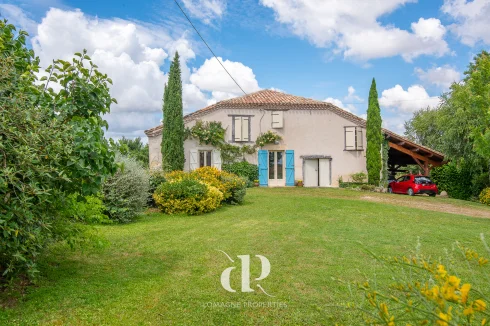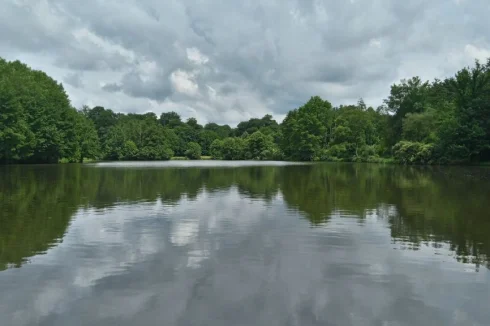Use of Wood Burning Stoves in France
Thursday 03 January 2019
The use of a wood-burning stove is a comparatively cheap and efficient form of heating in France, provided you choose your burner and your wood with care.*
The popularity of wood-burning stoves in France has increased significantly in recent years, driven by the new wave of high-performance wood-burners that have come onto the market, eco based tax breaks, and the high cost of alternative forms of heating.
Most wood burners are easy to use and diffuse their heat quickly and directly, although as they are generally only able to heat one room at a time they do sometimes require you make a choice about the use of living space in the home over winter.
The inconvenience of having to store the wood and replenish the chamber can also be removed by using wood pellets, which can easily be kept in the house and added to the fire.
However, if you wish to use pellets you will need to purchase an appliance designed specifically for that purpose; you cannot use them on a normal wood burning stove.
Whether logs or pellets, a key requirement of an efficient burn is to ensure that you purchase a stove of quality. There are many on the market, some at superficially attractive prices, but whose level of performance may well disappoint.
Stoves made of cast iron and fitted with fire bricks are generally considered the best performing and provided you buy one that has a transfer efficiency rating of at least 70% it is possible to obtain a tax credit of 30% (25% if replacement) of the purchase cost, up to a maximum of €16,000 for a couple. Only the cost of the wood burner itself qualifies for the tax credit, not the costs of installation, which must be carried out by a business registered professional.
Buying a burner with the kitemark «Flamme verte» is a sign of both good quality and ecological rectitude, and one that also offers access to the tax credit. Most companies in France have this label.
Check and confirm with your supplier that the burner meets the requirements for tax credit eligibility. They would normally need to also install to obtain the tax credit.
In order to qualify, the property would need to be your principal home; landlords and second-home owners are not eligible. There is, however, no test of resources, so whatever your income you have an entitlement.
Importantly, the tax credit (Crédit d’Impôt pour la Transition Energétique -CITE) is granted irrespective of whether you pay income tax, or only pay a small amount in tax. So, if you pay no income tax you will receive a cheque from the tax authority to the value of the tax credit.
Choice of Wood
It also pays to make a most careful choice of the wood you use. Once again, some 'bois de chauffage' advertised at superficially attractive prices may simply not be up to the job.
Wood quality can be classed into three main groups, according to their burning and heat characteristics. The first and best group comprises oak, hornbeam, beech, elm and maple. The second group comprises chestnut, acacia, and fruit trees. Finally, there are the softwood and coniferous trees - in the main, pine, plane, poplar, spruce, and birch.
Those trees in the first group offer heat of around 2,000 KWh per m3, whilst those in the remaining two groups produce around 1,700 KWh and 1,600 KWh respectively.
In addition, coniferous trees rich in sap burn quickly and tend to creosote up the flue more easily than hardwoods.
However, of far greater importance than the type of wood you use is that it is seasoned. Any type of wood not well-seasoned will perform poorly and cause problems in the flue. It will also more than likely soot up the glazing on your wood burner. You absolutely need to make sure that the wood you burn is dry and that it has been cut for at least two years.
If you are unsure what you are buying look for the label NF Bois de Chauffage as a guarantee of quality. Other labels to look out for are «France bois bûche» or «ONF Énergie bois».
If you can stock for at least a year, ask for wood of H2 class, as opposed to H1, which is ready for burning the year of purchase.
It will also be cheaper if you can stock it yourself. If you do, put it in a well ventilated area, with a cover over the top if in open air; avoid completely covering with a water proof membrane, as it will cause condensation.
Your wood burner size will determine the length of logs (bûches) you can buy and use. The sizes most widely used are 20, 25, 30, 40 and 50 centimetres.
A great amount of wood sold privately in the rural areas is sold in 50cm or 1 metre lengths, sometimes without being spilt. The longer lengths of unspilt wood will of course be cheaper, but that will of mean you will need to cut to size to suit your own requirements, not a task easily accomplished without decent equipment.
Wood is generally sold by the 'stère', whose equivalent m3 values are as follows:
- 1 stère of logs of 1 metre in length is equivalent to 1m3;
- 1 stère of logs 50cm in length is equivalent to 0.8m3;
- 1 stère of logs of 25cm in length is equivalent to 0.6m3.
Prices vary widely but expect to pay €50m3 at the very least, but they can reach over €100m3 in parts of the country.
Buying during spring or summer is generally cheaper than over the winter period. You will also need to consider transport to your property; most suppliers will deliver, some without charge, depending on distance.
Thank you for showing an interest in our News section.
Our News section is no longer being published although our catalogue of articles remains in place.
If you found our News useful, please have a look at France Insider, our subscription based News service with in-depth analysis, or our authoritative Guides to France.
If you require advice and assistance with the purchase of French property and moving to France, then take a look at the France Insider Property Clinic.





